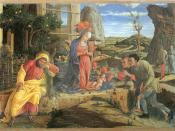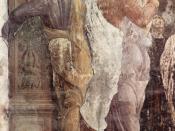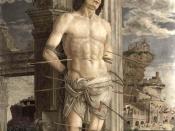"The Adoration of the Shepherds" is a painting that once adorned El Greco's tomb in the church of the Monastery of St. Dominic in Toledo. It was subsequently expended to the high altar for which it was initially meant. This rapturous painting is one of the artist's most colorful works. Light illuminates from the Child and the heavenly white cloth on which he lies, characterizing the figures of Mary and the astonished shepherds. Starting at the very beginning of his career El Greco had been attracted in the problem of light, his early work Youth Blowing a Charcoal is essentially an investigation of the way in which a burning light is mirrored by the features of the face.
When he painted "The Adoration of The Shepherds", light was no longer used for its own sake but as a mode to transport an idea. The words of the Pantocrator are occasionally to be found in Romanesque churches and consequently in the Light of the World.
In El Greco's picture this topic is now completely stated in absolutely pictured terms. The lengthened figures, like tongues of fire, and all the marks of eagerness, faith and emotion, are representative of El Greco's work. These characteristic features of El Greco's art are obviously seen in this gorgeous creation, which establish it as a link amid the Gothic style and modern art.
"El Greco's color expression was quite unlike the chiaroscuro style of da Vinci. He preferred abruptness and bold color contrast rather than the soft transition and glazed style of the time. In chiaroscuro, the highlights are pure and the shadows were dull -- the opposite of El Greco's interpretation. The rich deep tones and the chalky tints produced an eerie, yet powerful visual effect."
[The Secrets of the Masters - El...


